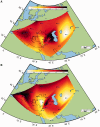The missing link of Jewish European ancestry: contrasting the Rhineland and the Khazarian hypotheses
- PMID: 23241444
- PMCID: PMC3595026
- DOI: 10.1093/gbe/evs119
The missing link of Jewish European ancestry: contrasting the Rhineland and the Khazarian hypotheses
Abstract
The question of Jewish ancestry has been the subject of controversy for over two centuries and has yet to be resolved. The "Rhineland hypothesis" depicts Eastern European Jews as a "population isolate" that emerged from a small group of German Jews who migrated eastward and expanded rapidly. Alternatively, the "Khazarian hypothesis" suggests that Eastern European Jews descended from the Khazars, an amalgam of Turkic clans that settled the Caucasus in the early centuries CE and converted to Judaism in the 8th century. Mesopotamian and Greco-Roman Jews continuously reinforced the Judaized empire until the 13th century. Following the collapse of their empire, the Judeo-Khazars fled to Eastern Europe. The rise of European Jewry is therefore explained by the contribution of the Judeo-Khazars. Thus far, however, the Khazars' contribution has been estimated only empirically, as the absence of genome-wide data from Caucasus populations precluded testing the Khazarian hypothesis. Recent sequencing of modern Caucasus populations prompted us to revisit the Khazarian hypothesis and compare it with the Rhineland hypothesis. We applied a wide range of population genetic analyses to compare these two hypotheses. Our findings support the Khazarian hypothesis and portray the European Jewish genome as a mosaic of Near Eastern-Caucasus, European, and Semitic ancestries, thereby consolidating previous contradictory reports of Jewish ancestry. We further describe a major difference among Caucasus populations explained by the early presence of Judeans in the Southern and Central Caucasus. Our results have important implications for the demographic forces that shaped the genetic diversity in the Caucasus and for medical studies.
Figures







 \udelta _{xy} are color coded in a heat
map with darker colors indicating higher haplogroup similarity with European
Jews.
\udelta _{xy} are color coded in a heat
map with darker colors indicating higher haplogroup similarity with European
Jews.Comment in
-
Highlight: out of Khazaria--evidence for "Jewish genome" lacking.Genome Biol Evol. 2013;5(1):75-6. doi: 10.1093/gbe/evs129. Genome Biol Evol. 2013. PMID: 23325386 Free PMC article. No abstract available.
Similar articles
-
No evidence from genome-wide data of a Khazar origin for the Ashkenazi Jews.Hum Biol. 2013 Dec;85(6):859-900. doi: 10.3378/027.085.0604. Hum Biol. 2013. PMID: 25079123
-
Abraham's children in the genome era: major Jewish diaspora populations comprise distinct genetic clusters with shared Middle Eastern Ancestry.Am J Hum Genet. 2010 Jun 11;86(6):850-9. doi: 10.1016/j.ajhg.2010.04.015. Am J Hum Genet. 2010. PMID: 20560205 Free PMC article.
-
A genome-wide genetic signature of Jewish ancestry perfectly separates individuals with and without full Jewish ancestry in a large random sample of European Americans.Genome Biol. 2009;10(1):R7. doi: 10.1186/gb-2009-10-1-r7. Epub 2009 Jan 22. Genome Biol. 2009. PMID: 19161619 Free PMC article.
-
Genomic microsatellites identify shared Jewish ancestry intermediate between Middle Eastern and European populations.BMC Genet. 2009 Dec 8;10:80. doi: 10.1186/1471-2156-10-80. BMC Genet. 2009. PMID: 19995433 Free PMC article.
-
Pitfalls of the Geographic Population Structure (GPS) Approach Applied to Human Genetic History: A Case Study of Ashkenazi Jews.Genome Biol Evol. 2016 Aug 16;8(7):2259-65. doi: 10.1093/gbe/evw162. Genome Biol Evol. 2016. PMID: 27389685 Free PMC article. Review.
Cited by
-
Highlight: out of Khazaria--evidence for "Jewish genome" lacking.Genome Biol Evol. 2013;5(1):75-6. doi: 10.1093/gbe/evs129. Genome Biol Evol. 2013. PMID: 23325386 Free PMC article. No abstract available.
-
Application of geographic population structure (GPS) algorithm for biogeographical analyses of populations with complex ancestries: a case study of South Asians from 1000 genomes project.BMC Genet. 2017 Dec 28;18(Suppl 1):109. doi: 10.1186/s12863-017-0579-2. BMC Genet. 2017. PMID: 29297311 Free PMC article.
-
Application of the geographic population structure (GPS) algorithm for biogeographical analyses of wild and captive gorillas.BMC Bioinformatics. 2019 Feb 5;20(Suppl 1):35. doi: 10.1186/s12859-018-2568-5. BMC Bioinformatics. 2019. PMID: 30717677 Free PMC article.
-
The GenoChip: a new tool for genetic anthropology.Genome Biol Evol. 2013;5(5):1021-31. doi: 10.1093/gbe/evt066. Genome Biol Evol. 2013. PMID: 23666864 Free PMC article.
-
The Origins of Ashkenaz, Ashkenazic Jews, and Yiddish.Front Genet. 2017 Jun 21;8:87. doi: 10.3389/fgene.2017.00087. eCollection 2017. Front Genet. 2017. PMID: 28680441 Free PMC article.
References
-
- Baron SW. A social and religious history of the Jews. New York: Columbia University Press; 1993.

